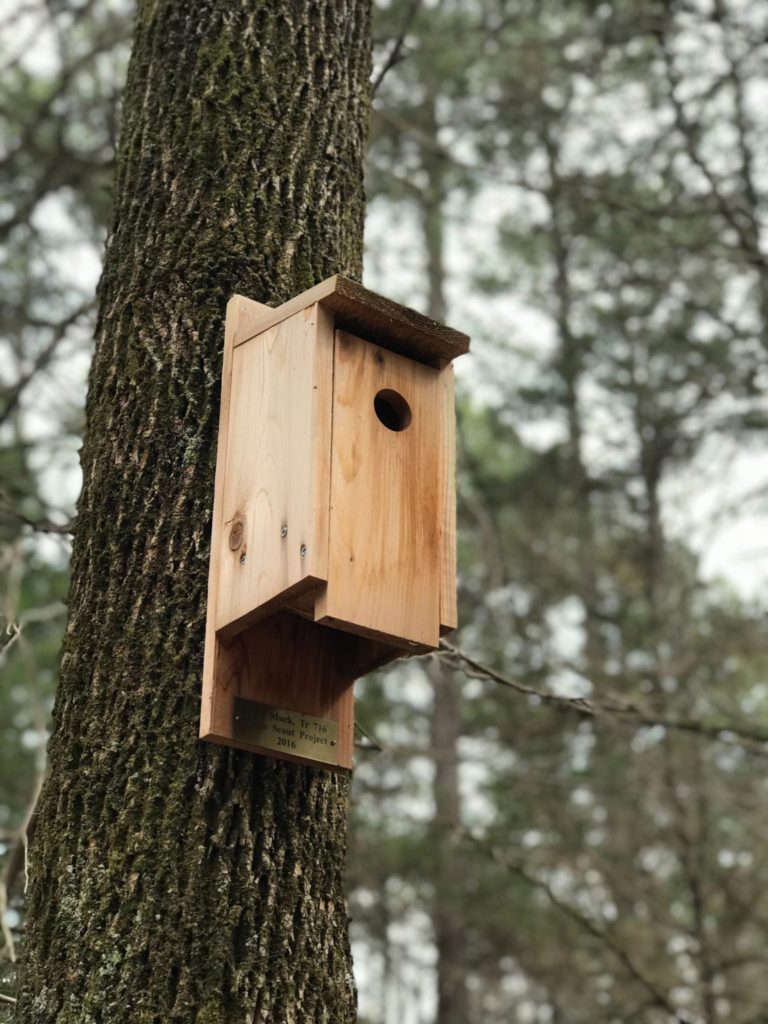Did you know that mounting a roost box in your outdoor space can help birds survive the winter? These wild bird shelters are a warm and cozy getaway from snowy and cold conditions, and can mean the difference between life or death for smaller backyard birds. But what, exactly, are roost boxes? Are they different from bird houses and nest boxes? And how can you attract birds to your new roost box? We’ll break it all down for you here.
What is a Roost Box?

A roost box, or roosting box, is a bird house that provides shelter for cavity-nesting birds, protecting them from inclement weather, cold temperatures, and predators. It’s built to accommodate multiple birds at once and to keep heat inside.
What’s the Difference Between a Roost Box, a Nest Box, and a Bird House?

Nest box
The simple answer is that nest boxes and roost boxes are bird houses that are different from each other in both purpose and structure. Roost boxes provide a safe, warm place for a greater number of birds to hunker down during winter. Nest boxes are meant for laying eggs and raising young, and birds will abandon it once they’re finished doing both.
A roost box is also typically much larger than a nest box, since roost boxes are made to keep multiple birds warm inside. Roost boxes also have thicker walls for better insulation during winter months. And they have fewer, or smaller, ventilation holes than nesting boxes. The entrance hole of a roost box is also closer to the bottom, keeping more heat trapped inside, as heat rises to the top. Additionally, some roost boxes are designed with several internal perches, allowing for many birds to roost comfortably inside.
Which Birds Use Roost Boxes?

Many types of birds use roost boxes, including:
- Bluebirds
- Titmice
- Downy woodpeckers
- Nuthatches
- Wrens
- Chickadees
- Swallows
- Flickers
- Owls
- Swifts
- Warblers
It’s not uncommon for multiple birds, and bird species, to be seen roosting together in a roost box. Wrens and nuthatches can often be found roosting together to keep warm on a cold night. And bluebirds often pile in together to stay warm. However, despite the cold, certain birds, like chickadees and woodpeckers, tend to skip the crowd and roost alone.
Thinking about building your own roost box? Check out this DIY video:
Where Should You Mount a Roost Box?
A roost box should be placed in an area that’s sheltered from the wind and rain, and at a height that keeps it safe from predators. With this in mind, we recommend mounting your roost box on a south-facing tree or pole, at a height of 6-15 feet from the ground. To further deter predators, consider adding a baffle under a pole-mounted roost box.
How Do You Attract Birds to Your Roost Box?
There are a few things you can do to make your new roosting box the perfect place to hunker down for the winter. Here are a few tips:
- Add a layer of moss or wood chips to the bottom for better insulation.
- Use caulk or tape to cover over any cracks in the roost box, to prevent heat loss.
- Clean the roost box regularly, removing feces, feathers, dirt, and other debris that’s built up over time.
- Mount it 10 feet or higher, as most birds feel safer the higher up they are.
Can You Turn a Nest Box into a Roost Box?
Yes, you can. Though they are typically smaller than roost boxes, nest boxes can be used to house smaller groups of roosting birds, or even single tenants. To “winterize” your nest box for roosting, you’ll first need to block ventilation holes; foam weatherstripping works well for this, as do strips of cloth. Next, add dried grass, hay, pine shavings, or some other natural materials inside as additional insulation. And, as roost boxes typically have a low entrance hole, you may be able to unscrew the front panel of the nest box and flip it so that the entrance hole is closer to the bottom.
What Else Can I Do to Help Birds Survive Winter?

We’re glad you asked! There are several things you can do, including:
- Put out one or more bird feeders.
- Learn about the importance of winter wild bird feeding.
- Get a heated birdbath for your backyard, garden, deck, patio, or balcony.
- Provide high-energy food sources like suet for your backyard birds.
Missed a Chirp Bird Walk or Talk? No Problem!
If you missed one of our popular bird walks or bird talks, we’ve got you! Check out the Chirp YouTube page to catch up! And to find out what’s happening next at Chirp, visit our Activities page.
Roost box photo courtesy of Christine Hanrahan and the Fletcher Wildlife Garden.



One comment
Very interesting!